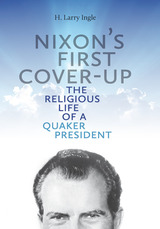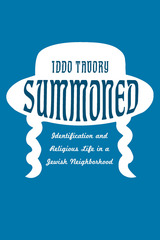3 books about Religious Life

Nixon's First Cover-up
The Religious Life of a Quaker President
H. Larry Ingle
University of Missouri Press, 2015
Have you ever thought you completely knew a story, inside and out, only to see some new information that shatters what you had come to accept as unquestioned fact? Well, Richard Nixon is that story, and Nixon’s First Cover-up is that new information.
With few exceptions, the religious ideologies and backgrounds of U.S. presidents is a topic sorely lacking in analysis. H. Larry Ingle seeks to remedy this situation regarding Nixon—one of the most controversial and intriguing of the presidents. Ingle delves more deeply into Nixon’s Quaker background than any previous scholar to observe the role Nixon’s religion played in his political career.
Nixon’s unique and personally tailored brand of evangelical Quakerism stayed hidden when he wanted it to, but was on display whenever he felt it might help him advance his career in some way. Ingle’s unparalleled knowledge of Quakerism enables him to deftly point out how Nixon bent the traditional rules of the religion to suit his needs or, in some cases, simply ignored them entirely. This theme of the constant contradiction between Nixon’s actions and his apparent religious beliefs makes Nixon’s First Cover-up truly a groundbreaking study both in the field of Nixon research as well as the field of the influence of religion on the U.S. presidency. Forty years after Nixon’s resignation from office, Ingle’s work proves there remains much about the thirty-seventh president that the American public does not yet know.
[more]

On the World and Religious Life
Coluccio Salutati
Harvard University Press, 2014
On the World and Religious Life (c. 1381) is the first surviving treatise of Coluccio Salutati (1332–1406), chancellor of the Florentine Republic (1375–1406) and the leader of the humanist movement in Italy in the generation after Petrarch and Boccaccio. The work was written for a lawyer who had left secular life to enter the Camaldulensian monastery of Santa Maria degli Angeli, located in the heart of Florence. The new monk prevailed on Salutati to write a treatise encouraging him to persevere in the religious life. His request led to this wide-ranging reflection on humanity’s misuse of God’s creation and the need to orient human life in accordance with a proper hierarchy of values. This work is here translated into English for the first time.
[more]

Summoned
Identification and Religious Life in a Jewish Neighborhood
Iddo Tavory
University of Chicago Press, 2016
On a typical weekday, men of the Beverly-La Brea Orthodox community wake up early, beginning their day with Talmud reading and prayer at 5:45am, before joining Los Angeles’ traffic. Those who work “Jewish jobs”—teachers, kosher supervisors, or rabbis—will stay enmeshed in the Orthodox world throughout the workday. But even for the majority of men who spend their days in the world of gentiles, religious life constantly reasserts itself. Neighborhood fixtures like Jewish schools and synagogues are always after more involvement; evening classes and prayers pull them in; the streets themselves seem to remind them of who they are. And so the week goes, culminating as the sabbatical observances on Friday afternoon stretch into Saturday evening. Life in this community, as Iddo Tavory describes it, is palpably thick with the twin pulls of observance and sociality.
In Summoned, Tavory takes readers to the heart of the exhilarating—at times exhausting—life of the Beverly-La Brea Orthodox community. Just blocks from West Hollywood’s nightlife, the Orthodox community thrives next to the impure sights, sounds, and smells they encounter every day. But to sustain this life, as Tavory shows, is not simply a moral decision they make. To be Orthodox is to be constantly called into being. People are reminded of who they are as they are called upon by organizations, prayer quorums, the nods of strangers, whiffs of unkosher food floating through the street, or the rarer Anti-Semitic remarks. Again and again, they find themselves summoned both into social life and into their identity as Orthodox Jews. At the close of Tavory’s fascinating ethnography, we come away with a better understanding of the dynamics of social worlds, identity, interaction and self—not only in Beverly-La Brea, but in society at large.
In Summoned, Tavory takes readers to the heart of the exhilarating—at times exhausting—life of the Beverly-La Brea Orthodox community. Just blocks from West Hollywood’s nightlife, the Orthodox community thrives next to the impure sights, sounds, and smells they encounter every day. But to sustain this life, as Tavory shows, is not simply a moral decision they make. To be Orthodox is to be constantly called into being. People are reminded of who they are as they are called upon by organizations, prayer quorums, the nods of strangers, whiffs of unkosher food floating through the street, or the rarer Anti-Semitic remarks. Again and again, they find themselves summoned both into social life and into their identity as Orthodox Jews. At the close of Tavory’s fascinating ethnography, we come away with a better understanding of the dynamics of social worlds, identity, interaction and self—not only in Beverly-La Brea, but in society at large.
[more]
READERS
Browse our collection.
PUBLISHERS
See BiblioVault's publisher services.
STUDENT SERVICES
Files for college accessibility offices.
UChicago Accessibility Resources
home | accessibility | search | about | contact us
BiblioVault ® 2001 - 2024
The University of Chicago Press









